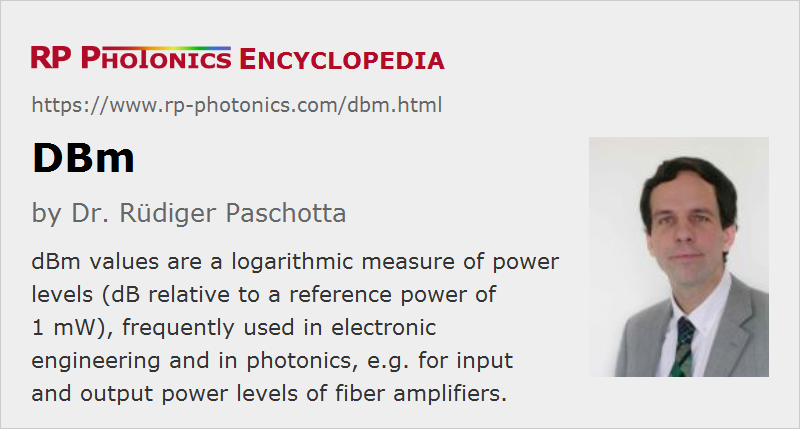dBm
Definition: dB relative to a reference power of 1 mW
Categories: optical amplifiers, lightwave communications
How to cite the article; suggest additional literature
Author: Dr. Rüdiger Paschotta
In electronic engineering and also in photonics, power levels are frequently specified with dBm values, which are a logarithmic measure. They are defined as decibels relative to a reference power level of 1 mW. It is thus a dimensionless unit, actually specifying a power ratio rather than a power.
For example, 0 dBm corresponds to 1 mW, 10 dBm to 10 mW and 20 dBm to 100 mW. Each increase of the power by a factor of ten (e.g. caused by an optical amplifier with 10 dB gain) adds 10 dBm.

Typical Applications
dBm values are convenient e.g. in the context of systems containing amplifiers, because one may simply add an amplifier gain in dB to obtain the dBm value of the amplified power level. Similarly, one can subtract dB values specifying power losses. Therefore, such specifications are quite common in optical fiber communications, where gain and losses occur in fiber amplifiers, at fiber splices and within passive optical fibers, for example. Optical spectrum analyzers and optical power monitors also often display dBm values.
In the context of electronics, even voltages and currents (e.g. of audio signals) are often specified in dBm; this is possible by assuming a certain reference value of the impedance, which may e.g. be 50 Ω or 600 Ω. With such an impedance value, one can calculate the electrical power associated with a voltage or current, and thus calculate the dBm value.
dBm in Spectral Quantities
Such logarithmic specifications can look somewhat confusing in the context of spectral quantities. For example, if a spectral flux, which would normally have to units of W/nm (or W/Hz), is specified with dBm/nm, this should not be understood as “dBm per nanometer”, but rather as “dBm in a bandwidth of 1 nm”. One should be aware that the dBm value would not double if the reference bandwidth were increased to 2 nm; instead, it would rise by 3 dBm.
Questions and Comments from Users
Here you can submit questions and comments. As far as they get accepted by the author, they will appear above this paragraph together with the author’s answer. The author will decide on acceptance based on certain criteria. Essentially, the issue must be of sufficiently broad interest.
Please do not enter personal data here; we would otherwise delete it soon. (See also our privacy declaration.) If you wish to receive personal feedback or consultancy from the author, please contact him e.g. via e-mail.
By submitting the information, you give your consent to the potential publication of your inputs on our website according to our rules. (If you later retract your consent, we will delete those inputs.) As your inputs are first reviewed by the author, they may be published with some delay.
See also: decibel
and other articles in the categories optical amplifiers, lightwave communications
 |




If you like this page, please share the link with your friends and colleagues, e.g. via social media:
These sharing buttons are implemented in a privacy-friendly way!